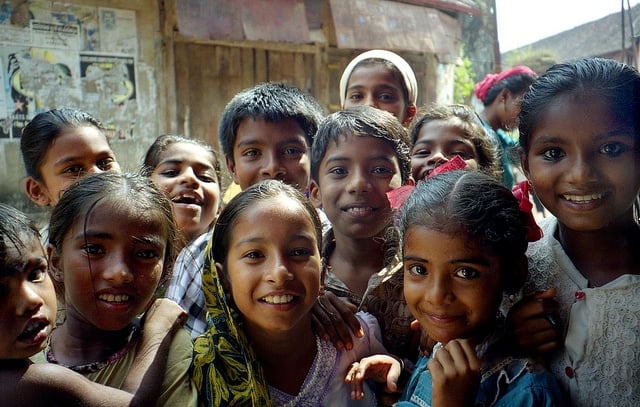
by World Moms Blog | Aug 28, 2014 | 2014, Awareness, Being Thankful, Childhood, Cultural Differences, Culture, Domesticity, Education, Eye on Culture, Family, Grandparent, Guest Post, Home, India, International, Kids, Life Lesson, Motherhood, Nutrition, Parenting, Relationships, Traditions, World Motherhood, Younger Children
 Motherhood is one of the most beautiful experiences of a woman’s life. Raising children makes life full. I am raising my children in India and I feel that the environment in India helps a lot in inculcating a strong set of values.
Motherhood is one of the most beautiful experiences of a woman’s life. Raising children makes life full. I am raising my children in India and I feel that the environment in India helps a lot in inculcating a strong set of values.
I read a lot about the many ways children are raised in various parts of the vast Indian subcontinent. Here are some of the enriching reasons I find raising a child in India so wonderful:
1. Family Help: India is a country where the joint family system is prevalent. Children grow up having a lot of fun surrounded by generations of Grandparents, Uncles, Aunts and Cousins. This helps the child in her personal growth and instills great concepts like teamwork and adjusting to different kinds of people, with different mindsets. It also helps a child understand how to receive and give unconditional love.
Sadly, the joint family is breaking up nowadays and giving way to nuclear families. The nuclear family comprises of just the husband, wife and children. Sometimes, the husband’s parents come to stay. This helps build a strong bond between the children and the grand parents, which should be encouraged. The child will learn to respect traditional values which are an integral part of the Indian social fabric.
2. Learning to Respect Your Elders: Indian children are taught to respect their elders and extended family at a young age. Being around so many family members, children learn to show respect and love to one and all when they grow up. Some communities in India make it compulsory for the young people to touch the feet of the elders as the mark of reverence.
This custom is rarely found in any other culture across the world. This custom is instilled in the child’s mind from a very young age and it becomes second nature. This custom hasn’t changed even after western ideas and practices stealthily crept into India.
3. Kids Are Taught How to Save: Children in India are taught to save and not spend unnecessarily. Due to the conservative economy, Indian children learn at a very young age to prioritise their expenses. They learn to buy things which will give them value for money.
Nowadays many banks offer the option to open minor accounts for very small children. Instead of having children save their pocket money in piggy banks, they can save it in real banks. This teaches the child banking procedures at a very early age. Children can even maintain a separate copy for calculating the total expenditure. This will teach the child that it is not good to waste money.
4. Family Values: Children are inculcated with strong family values as they grow up among numerous family members. These family values help develop strong moral fiber. In the long run, they help in creating a strong personality which helps in their growth.
5. Character Development: Character defines how the child leads a holistic life. Parents in India work hard on character building for their child. Since all parents’ desire that their child grows up to become an honest and good human being.
6. Spiritual Discipline: Indian children are raised with enormous spiritual discipline. India is the land for spiritual growth and developing the spiritual qualities in a child helps him/her grow up to be a better individual. Children are taught about the importance of religion and customs. They are also taught to respect other religions as well, since the common idea of all religion is to achieve peace, moral strength and happiness.
7. Freedom When They Play: There is no requirement for an organized play time. A child will always find a group of children playing outside his house. So they can always find fun. They can step out any moment and experience a joyous playtime. Open spaces or children’s parks are still there and are not encroached by developmental activities and high rises.
8. Sharing and Caring: There is a lot of sibling bonding in Indian families. Parents teach children tolerance towards each other, love and patience. By sharing and caring for each other, this turns them into well-adjusted human beings.
9. Celebrating Traditions: India has one of the richest cultures which dates back more than 5000 years. So India is a land of festival and colors, cliché as it may sound, it is true. These celebrations are elaborate. All the kids are involved in the celebration of the festivals with the other children in the community. The children celebrate the festivals with their families and extended families.
10. Healthy Eating Habits: Emphasis is laid on eating healthy food. Children are allowed to eat junk food once in a while, but mothers cook at home. They are happy to feed the children with home cooked food. This makes the child health conscious. Mothers teach their children to choose healthy fresh fruits and vegetables. This also increases their knowledge about what is good for them.
The above stated facts hold true for a small portion of the Indian population, as the phrase goes ‘the privileged few’. Economically, India has progressed considerably in the last 60 years. The bigger picture, however, is quite different: a farmer hangs himself from a tree because he cannot provide for his family; a child is shunned from temples and public places due to his lower caste label; the rampant poverty in villages and lack of health amenities lead to reduced life expectancy; more children are seen carrying bricks and working in factories than in classrooms. These are children who don’t have access to formal education at all.
But for increasingly more kids, growing up in India is a blissful experience which helps them develop into amazing individuals. The calmness of spirit and the enriching environment in India is what gives these children an opportunity to explore life and themselves. The liveliness of the child is based on the amazing cultural forum that the Indian child inherits.
In contrast, malnourished children peddle the streets and somehow make a living. They are deprived of things that my child claims as basic rights. We have small children selling chai when they should be drinking a warm glass of milk instead. Yet from children like these, a leader has emerged – Narendra Modi. The contradictions and ironies of my country keep me enthralled. I trudge forward in earnest hope that my child will triumph in all spheres of her life.
Also, the technological development and fast paced life have made us so busy that we are finding less and less time for each other but still Indians never forget to smile at one another. Children brought up in India will never lose heart, since they have learned to struggle and attain victory in all fields of life. But to make that happen, we need to remember the wisdom Dr. Seuss imparted:
“Unless someone like you cares a whole awful lot, nothing is going to get better. It’s not.” — The Lorax
The image used in this post is credited to Ryan Ready. It holds a Flickr Creative Commons attribution license.
This is a first-time, guest post from Aradhana, a mother in India. Aradhana also is a passionate writer, who focuses on topics like yoga, wellness, health and lifestyle. She has contributed posts to Natural News, Wiki How, MomJunction, and Elephant Journal. Through her writings, she hopes to motivate people to develop healthy habits and adopt natural ways of living to achieve sound health.
World Moms Blog is an award winning website which writes from over 30 countries on the topics of motherhood, culture, human rights and social good. Over 70 international contributors share their stories from around the globe, bonded by the common thread of motherhood and wanting a better world for their children.
World Moms Blog was listed by Forbes Woman as one of the "Best 100 Websites for Women 2012 & 2013" and also called a "must read" by the NY Times Motherlode in 2013. Our Senior Editor in India, Purnima Ramakrishnan, was awarded the BlogHer International Activist Award in 2013.
More Posts

by Maureen | Jul 24, 2014 | 2014, Eye on Culture, Indonesia, Scoops of Joy, World Motherhood

An Indonesian father with child
Would you believe me if I tell you I have NEVER heard of Father’s Day until I moved to America in 2005.
Yes, true story!
Here in Indonesia we just simply don’t have Father’s Day.
We do have Mother’s Day on December 22, 2014. The holiday is celebrated on the anniversary of the opening day of the first Indonesian Women Congress, which was held from 22 to 25 December 1928. The Congress was attended by 30 feminist organizations from 12 cities in Java and Sumatra. In Indonesia, feminist organizations have existed since 1912, inspired by Indonesian heroines of the 19th century, e.g., Kartini, Martha Christina Tiahahu, Cut Nyak Meutia, Maria Walanda Maramis, Dewi Sartika, Nyai Ahmad Dahlan, Rasuna Said, etc. The Congress intended to improve women’s rights in education and marriage.
We also have Kartini Day on 21 April to celebrate the emancipation of women spearheaded by an activist, Raden Ajeng Kartini.
So why do we have no Father’s Day then?
Could it be because we as a country are already too patriarchy?
I actually wonder about that too. So like a good citizen, I turned to Google and did a little research.
What do you know, actually we do have one and it’s called “Hari Ayah” in Indonesian which means Father’s Day. It was declared in 2006 it falls on 12 November. That explains why very few people are aware of this and it’s not popular. Maybe because we don’t commercialize it as much as mother’s day? I have never seen an advertisement for local Father’s Day.
Technically, men still perceived to have higher place than women in Indonesia. Like it or not, that’s the truth. We are still plagued by social injustices caused by a male-dominated society that abandons women to the whims of their husbands. So maybe that’s why it is more ‘common’ to celebrate Mother’s Day.
Being from a whole intact family unit of a father and a mother doesn’t guarantee that the father is always hands-on, and I think this happens in many different countries, too. I have personally seen mentally checked out fathers who leave all the responsibilities of raising children solely to their wives by justifying they are too busy making a living for the family. Many men still believe their fatherhood role is simply to provide for the family and that’s it. I feel for women who literally are acting as single parents in a married-life.
Being a mother myself, I can truly appreciate a man who helps out his wife. I celebrate hands-on fathers, like my own father. My father is a strong dominant male figure to me and many people will be surprised by how hands-on he has been. I can still recall him changing my brothers’ diapers, doing the dishes (something he still does to this very day!) and other domestic chores without complaining, going to the market for my mother and many more. He was even actively involved in our schools’ boards. He works hard, yet, he was and is always there.
And now seeing my own younger brother being very hands-on in caring, raising his first daughter truly warms my heart. My sister-in-laws’ friends pointed out that their own husbands do not even want to change diapers, but my brother changes diapers and more.
This made me realize how lucky we are to have our father as a big role model who set great living standards of what a great father is like.
So although Father’s Day is not hugely popular here, I salute all men who break the stereotype of fatherhood in my country. Hats off to you!
When do you celebrate Father’s Day in your country? How do you celebrate Father’s Day?
This is an original post by our World Mom, Maureen of “Scoops of Joy” in Indonesia for World Moms Blog.
Photo Credit: http://www.stockvault.net/photo/152311/asian-child-with-father

by Karyn Wills | Jun 23, 2014 | 2014, Awareness, Being Thankful, Brothers, Childhood, Culture, Education, Eye on Culture, Kids, Multicultural, Music, Nature, New Zealand, School, Siblings, Traditions, World Motherhood
 It’s mid-winter in New Zealand. The air is crisper than I’ve felt it for a while, the leaves have pretty much fallen and we have had the shortest day of the year.
It’s mid-winter in New Zealand. The air is crisper than I’ve felt it for a while, the leaves have pretty much fallen and we have had the shortest day of the year.
This week also saw the appearance of the star cluster, Matariki, (The Pleiades), which heralds the Maori New Year.
This was not a festival I had ever heard of growing up but it has been revised and reinstated and there are now celebrations being held all around New Zealand. While different tribes traditionally celebrated Matariki in their own fashion, now it is universally marked by the new moon and rising of the Matariki star cluster with festivities running from 1st June to 30th July.
Traditionally, Matariki was a time of celebration, important for navigation and the timing of the seasons. It was particularly relevant to the preparation of the ground for the upcoming growing season and offerings to the gods, and specifically, Rongo, the Maori god of cultivated food.
Only a few New Zealand schools consistently mark mid-winter and Matariki but for our boys’ school, festivals are an important part of the culture and I have two mid-winter events to attend this coming week.
On Wednesday evening, my youngest son has a lantern walk through a public garden. Imagine a waterfall and a large pond with a bridge over it and a stream running throughout. Imagine 30 or so small (3-6 year-old) children clutching a paper lantern with a candle in one hand and a parent’s hand in the other as we meander through the park in, otherwise, pitch black. We will wander past tiny grottos of handmade gnomes and crystals, we will attempt to sing (although for the children, it’s enough that they manage to walk and stay upright!) and we finish gathered together, munching on a star shaped, ginger or shortbread biscuit.
On Thursday evening, my older sons have their mid-winter festival, beginning with a shadow play performed by their teachers. After the play, the children who are between 10 and 14 gather in small groups amongst the trees at school and the youngest children, guided by their lanterns and teachers, meander from group to group and hear the older children entertain them with a song, or a poem or a tune. The 10 year-olds then follow behind the youngest to see the older children’s performances and the 11 year-olds follow them, and so on. They will finish with their classmates and a biscuit and warm drink.
The magic in these events is heart-warming and the children just seem to absorb the atmosphere; they appreciate the small snippets of light amongst the darkness, the companionship, the quiet musicality of the ’entertainment’ and especially the sharing of food at the end! (So do I.)
Do you celebrate mid-summer and mid-winter? How do schools where you live mark these seasonal events?
Sources: NZ Ministry of Culture and Heritage; Wikipedia
This is an original post to World Moms Blog by our writer and mother of three boys in New Zealand, Karyn Van Der Zwet.
The image used in this post is credited to Wikipedia images with editing from Dayne Laird (Ministry for Culture and Heritage, NZ)
Karyn is a teacher, writer and solo mother to three sons. She lives in the sunny wine region of Hawke’s Bay, New Zealand in the city of Napier.
More Posts

by ThinkSayBe | Jun 12, 2014 | 2014, Africa, Awareness, Being Thankful, Communication, Discipline, Education, Expat Life, Eye on Culture, Family, Girls, Humor, Older Children, Parenting, Technology, Teenagers, ThinkSayBe, USA, World Motherhood
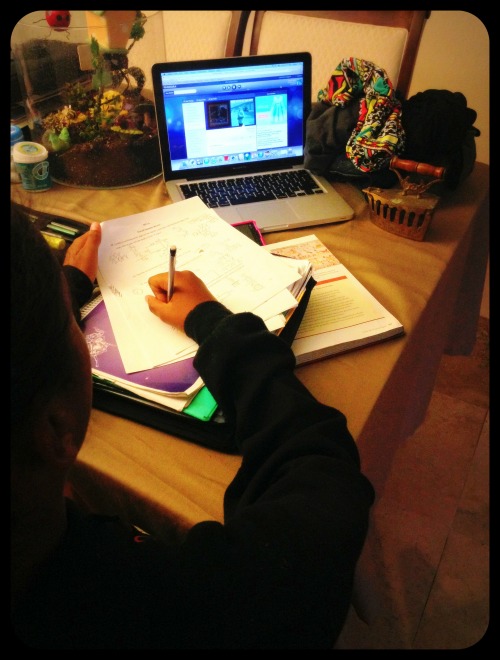
“But mom, why can’t I do my homework in front of the TV??? I’m not watching it, I’m just listening to it!!”, says my 12-year-old girl, emphasizing the word ‘watching’ with a half roll of the eyes.
My daughter is a really cool human & a great child. She is a tween so craziness and challenges come with the territory. Still, she has sweet moments, and she “OKs” everything, whether she remembers later or not.
But, my life was very different growing up in Italy and then Tanzania…
By age 9 my older brother & I alternated daily chores. We had to do dishes & sweep daily. There was no dillydallying, no talk-back, no having to dry our hands to like a song on Pandora…. none of that. We did homework on the kitchen table, our beds, in the yard, and wherever else. After I was done with homework I’d have to use the house phone, speak to a parent with good phone manners, & find out if my friends could come play. There was no texting them.
Everyone knew our plans; at least initially (smile). Outside we used our imagination to play with nothing. We picnicked under a tree in this huge sunflower field. We rode our bikes in circles in the bus’ parking lot and made sure we were home when the lights came on.
When I was 11 we moved back to Tanzania. Life here was drastically different, yet, in some respects there was more access to things than we had in the small Italian town we lived in. However, constant electricity and running water were gone. We had a western toilet in our home, but often had to use toilets requiring squatting, be they a hole over a sceptic tank, or an Eastern latrine. Not having water & electricity all the time required planning.
Though there was hired help, we also had to fetch water. If you don’t like fetching water you learn to use it sparingly. You take a shower from a bucket that’s a quarter full and come out clean! You recycle water so that first you wash your hair by dipping it into the bucket, then use the same water as the first cycle of your laundry, which you wash by hand. Having city-wide rationed electricity, meant ensuring you have kerosene, wick for lamps, and match sticks. You actually needed plenty of match sticks in Tanzania, because there is this one brand that makes them and you’re lucky if one out of five matches actually lights up & stays lit. HAHA!
We must see these things as humorous. Lack of electricity and paying for it in advance, meant using it responsibly. The radio would be on, and so would the TV for some parts of the day. We knew to close the fridge fast and to unplug the iron as soon as the job was done. Ironing was not always done with an electrical iron, either. Some times we would use a charcoal iron. It sounds like it’s from an entire different era, right? It’s still being used. A charcoal cast iron had to be used carefully. You’d also plan how to get hot coals so instead of wasting charcoal, kerosene fuel, and good match sticks, you’d use the charcoal for cooking. That required planning as well. A lot of planning and patience for a youngster, and children had to consider all these things from toddlerhood!
I am so infinitely grateful we lived this kind of life in my teenage years. Though I am sure I threw crazy hormonal arrows (figuratively speaking) at my mom, I think that having to deal with these realities made me get myself together quickly, thus sparing her six years of teenage craze. As far as school goes…wow! We had mandatory knee-high socks & buffed black shoes, mandatory hair pleats that I never had, monitors & prefects who thrived on their power to make us kneel for ‘misbehavior’, and hit-happy, switch-carrying teachers in the hallways who would whack you for no good reason.
In elementary school we had to chant….slowly & loudly…..”GOOD MORNING TEACHER!” Then we’d answer & ask, “FINE THANK YOU TEACHER, AND HOW ARE YOU, TEACHER?”, then we’d be permitted to sit down. In boarding school we had exactly 30 minutes to eat. The first year we ate food we individually cooked the night before, hoping it was still good without refrigeration. As a senior, food was made for us, so we’d hope it was ready & that we didn’t have to scoop bugs out of our beans. We’d always wash our dishes before returning to class. All of this, in 30 minutes.
At this school there was no corporal punishment. However, if we were late or didn’t follow other rules, we’d have some agricultural work for at least one period.
We studied in the hall after we cleaned our dinner mess. After two hours of supervised solid studying, we’d return to our hostel rooms (mine had four bunk beds with three beds each), and lights were out by 10pm. Everyone took showers in the morning, which I found to be unnecessary as the water was very cold, so I would leave some water in the courtyard for the sun to heat , and take a shower after school.
When I came to the United States I didn’t think I had a different work ethic than anyone else. I thought we all work hard & have different struggles. As the years passed I began to see certain differences & felt extremely fortunate for my history as it was.
As a girl I was lucky that my mother (who is partially Afghani & Punjabi) didn’t believe that I was worthless, blessed that she believed in education and sent me to school. I was also fortunate that I wasn’t betrothed at a young age, or at all. As I was in college I understood that I was privileged and had to make other women proud.
I would have to get the best grades, be a well-rounded student & not take electricity and running water for granted. So when my daughter asks why she can’t do her homework in front of TV, I don’t know what to say! OK, I do answer her, trying to use logic she’ll understand. She visited Tanzania for a few months in 2010, but she cannot relate to my history.
When my daughter was round age four she always asked if she could help with chores, but as I tried to rush I’d ask her to draw or play instead. I thought the environment around us would do for her what it did for me at her age. I knew I wasn’t in Italy, or in Tanzania, but I still thought I wouldn’t be the only one pushing for a balanced human. I also didn’t anticipate technology advancing so incredibly fast & how much gadgetry she would have at her disposal. In retrospect I should have encouraged her willingness to help.
She is now 12, doesn’t like to do any chores other than the occasional Swiffer mopping. She wants to do homework while listening to TV, somehow ignoring the visuals, and she wants to spend her other homework time listening to pop songs. She does practice Brazilian Jiu Jitsu and has a unique passion for it. But when not doing her school work, she looks at photos with funny quotes, watches short videos, and messages her friends on her phone. Our lives are so different. How do I teach her what I’ve been taught?
Is it drive? Is it thirst? Can you relate? How do you teach your children how to work hard? Please share your findings with me!
This is an original post to World Moms Blog by Sophia in Florida, USA. You can find her blogging at Think Say Be and on twitter @ThinkSayBeSNJ.
Photo credit to Trocaire. This photo has a creative commons attribution license.
I am a mom amongst some other titles life has fortunately given me. I love photography & the reward of someone being really happy about a photo I took of her/him. I work, I study, I try to pay attention to life. I like writing. I don't understand many things...especially why humans treat each other & other living & inanimate things so vilely sometimes. I like to be an idealist, but when most fails, I do my best to not be a pessimist: Life itself is entirely too beautiful, amazing & inspiring to forget that it is!
More Posts
Follow Me:


by Purnima Ramakrishnan | Jun 11, 2014 | 2014, Brazil, Cultural Differences, Culture, Eye on Culture, India, Purnima, Sports, The Alchemist, World Interviews
Every four years, a large part of the world’s attention descends on one nation – for World Cup Football. Tomorrow, the FIFA World Cup actually starts, and as you all know, the first match is in Sao Paulo, where Brazil takes on Croatia. I was on the phone with fellow World Moms Blog editor, Jennifer Burden, and she asked me if India is excited for the World Cup.
My own family has World Cup fever, inspired by my recent trip to Brazil to report on world poverty and environmental issues, but when I think of the whole of India excited about something sport-related, it is really only cricket that comes to mind!
People in India will watch the World Cup games, but it won’t compare to our country’s level of excitement over cricket.
When it comes to sports, India is a cricket-crazy nation.
INDIA.IS.A.COMPLETE.CRICKET-CRAZY.NATION!
Men, women and kids all watch and/or play and/or have favorites and/or conduct mass prayers and/or do just crazy things for the sake of cricket. There is really no end to it!
Sachin Tendulkar, a cricket player, is like a God to everyone in India. And there is absolutely no limits to what people would do for cricket. It is not just a game. Cricket has a very special life and a very special relationship with this country. It cannot even be explained, however, living in India during the cricket season would say it all.
Let me entertain you with a few crazy things that go on in India around cricket…
People color themselves with the tricolor Indian flag. The tricolor theme is not just clothes and caps, but you can find it also in the school premises, in apartments (flats) — theentire nation in is the colors of the Indian flag for the cricket. The celebrations are as intense, if not more, (ok, I have to be honest- it is the most celebrated event) than even Diwali or the Independence Day.
Check out this picture of a school in Western India where the school children are rooting for the Indian cricket team.
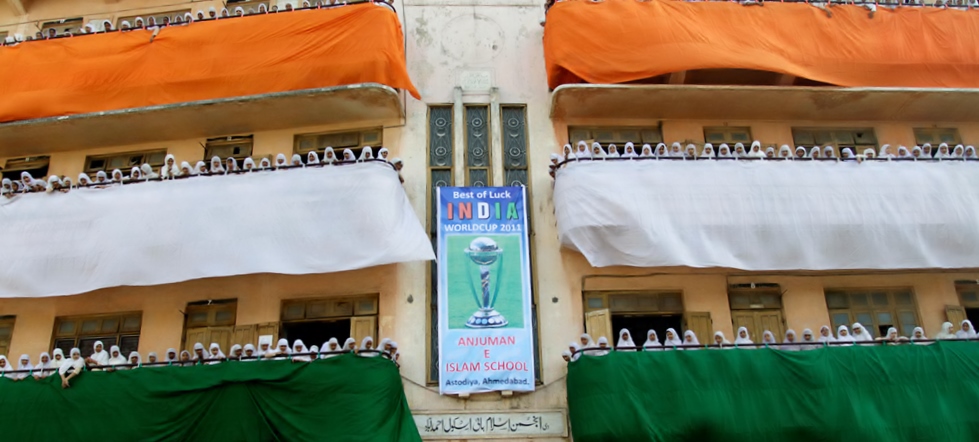
And then people just form throngs everywhere during the actual time the game is telecast. Office-goers, housewives, school-children, get together wherever there is a TV and watch. Homeless people watch cricket on the TV sitting on the streets across an electronics shop (or TV shop). No, they aren’t driven away. Because it is cricket season.
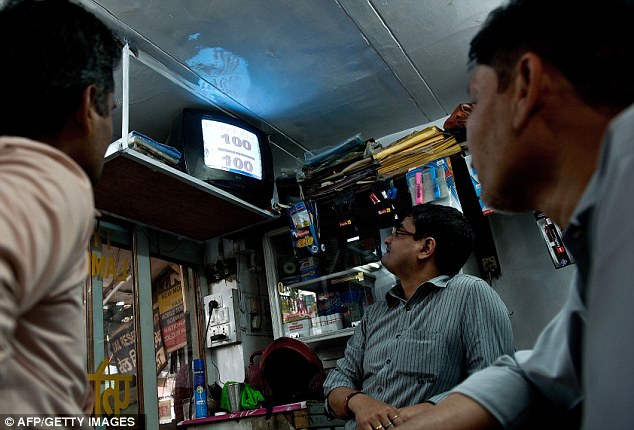
Shopkeepers let the customers watch the match from the shop indefinitely
There are common TV viewing holes in villages like the local tea-stalls, community centers, even movie theaters at times, a common TV in the square of the slum. Oh, there is no end to this kind of thing. These pictures to do the job of explaining the craziness cricket causes for the people of India and the rest of sub-continent countries (Pakistan, Sri Lanka and Bangladesh).
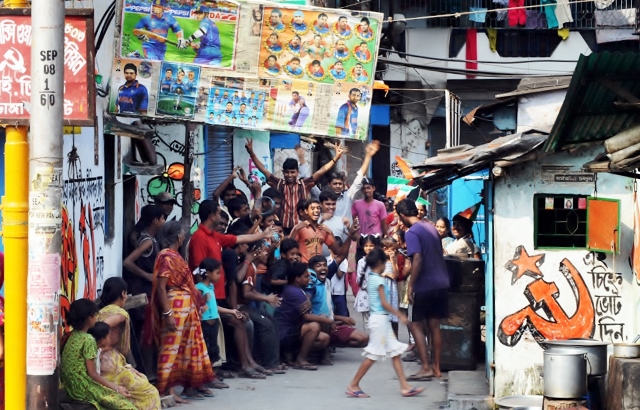
A tea stall hosting the TV viewing of the cricket match to a gathered crowd of the villagers
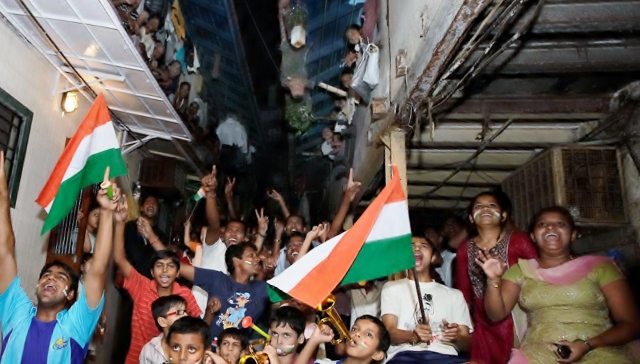
The slum dwellers watching the cricket match from a local TV-hole in the slums.

This is a mall in Kolkatta where the finals of the match between India and Sri Lanka is viewed.
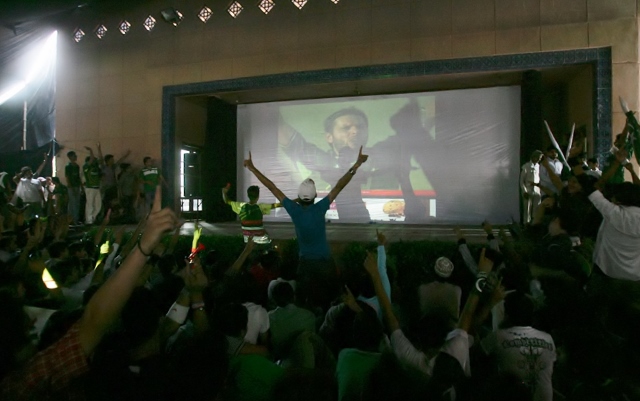
This is a movies theater in Karachi, Pakistan where cricket is telecast during the cricket season.
So, now coming back to the FIFA World Cup to be held in Brazil, all that I would say is that, the temperature is slightly lukewarm in comparison to the fever of the cricket playing nation.
Yes, we do talk a lot about it. But I guess that is about it. And, perhaps, some real football fans would watch it because they are really that – football fans.
By the way, did you catch Brazilian World Mom, Eco Ziva’s, post on the World Cup this week?
So what happens in your country? Is it a football-crazy country too? Or does your country live for some other sport?
Photo credit to the author, The Daily Mail and The Atlantic.
This is an original post to World Moms Blog written by Purnima Ramakrishnan, our Senior Editor from India.

by Tinne from Tantrums and Tomatoes | May 5, 2014 | 2014, Awareness, Being Thankful, Belgium, Communication, Cultural Differences, Culture, Eye on Culture, Family, Holiday, Husband, Inspirational, International, Kids, Motherhood, Tantrum and Tomatoes, Traditions, Womanhood, World Motherhood
 These days, the internet is humming with all things Mother’s Day related: special brunches, crafts, gift ideas. All for that special person you get to call ‘Mom’.
These days, the internet is humming with all things Mother’s Day related: special brunches, crafts, gift ideas. All for that special person you get to call ‘Mom’.
Mother’s Day earned its place on the calendar thanks to the efforts of American Anna Marie Jarvis. She organized the first Mother’s Day to commemorate her own mother, Ann Reeves Jarvis, who had helped organise the ‘Mother’s Day Help Clubs’ during the American Civil War. In 1914, Woodrow Wilson decided that Mommy Dearest would get her special day each second-Sunday of May.
Not here. In the rest of Belgium, yes. But not in the province of Antwerp. Here we wait until the 15th of August.
Not because we disdain the second Sunday of May, nor have a problem with holidays coming from across the Atlantic. No, as a matter of fact both the American and Antwerp traditions originated at much the same time.
For Antwerp and its surroundings it all began in 1913 when Antwerp born artist Frans Pieter Lodewijk van Kuyck started the tradition as a way of getting people to pay more attention to family values and social order. Modernisation and the industrial revolution, Mr. van Kuyck felt, had screwed society up a wee bit too much and it was time to take a stand, to defend traditional ways.
And since Mother is at the core of the family, when better to highlight her importance than on the 15th of August, the feast of the Assumption of the Virgin Mary. A Catholic feast already celebrated in Antwerp with a huge procession honouring the Virgin as protector of the city. There already was a party going on anyway, so why not add a little extra?
Mr. van Kuyck was not only an artist, he was also alderman for Culture and Fine Arts of the city of Antwerp. So in this official capacity he set up a propaganda committee, mobilised schools, companies and media into promoting the celebration of Mother. Children were to make a special gift and fathers were expected to buy flowers or jewellery. Brunch had not yet come into fashion then, otherwise I’m sure he would have made it mandatory too.
The rest of Belgium did not follow, but instead adapted the new ‘American’ version. Thus, during May when every other mother in the country smiles her lovely so-happy-with-the-macaroni-necklace smile and updates her Facebook status with pictures of her breakfast in bed/fresh flowers/chocolates/whatever…we trudge on and wait our turn until August.
Have no fear, thanks to the school’s Craft Hour, I too receive a pretty handmade gift from my daughters in May. But my husband still has to buy my flowers in August. Nah.
Does your country have a special Mother’s Day tradition? Or do you celebrate differently?
This is an original post to World Moms Blog from our writer in Belgium, Tinne, of Tantrums and Tomatoes.
The image used in this post is credited to the author.
Born in Belgium on the fourth of July in a time before the invention of the smart phone Tinne is a working mother of two adorably mischievous little girls, the wife of her high school sweetheart and the owner of a black cat called Atilla.
Since she likes to cook her blog is mainly devoted to food and because she is Belgian she has an absurd sense of humour and is frequently snarky. When she is not devoting all her attention to the internet, she likes to read, write and eat chocolate. Her greatest nemesis is laundry.
More Posts - Website
Follow Me:



 Motherhood is one of the most beautiful experiences of a woman’s life. Raising children makes life full. I am raising my children in India and I feel that the environment in India helps a lot in inculcating a strong set of values.
Motherhood is one of the most beautiful experiences of a woman’s life. Raising children makes life full. I am raising my children in India and I feel that the environment in India helps a lot in inculcating a strong set of values.























